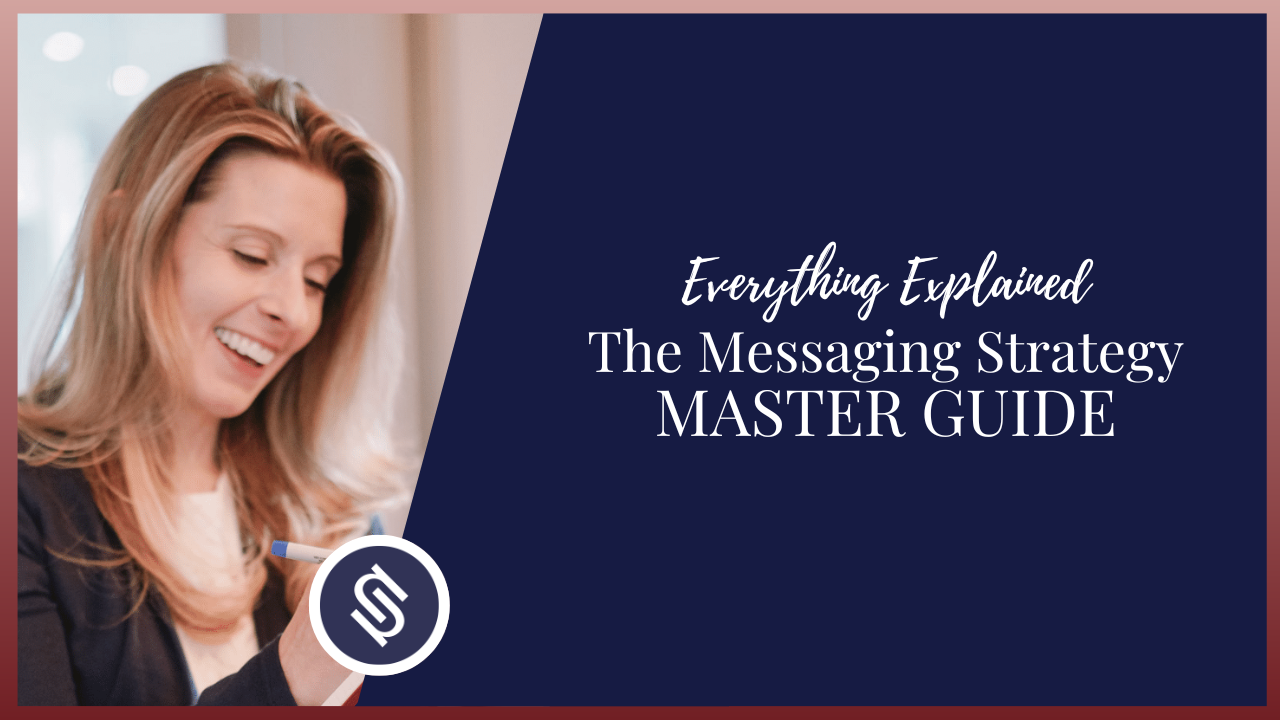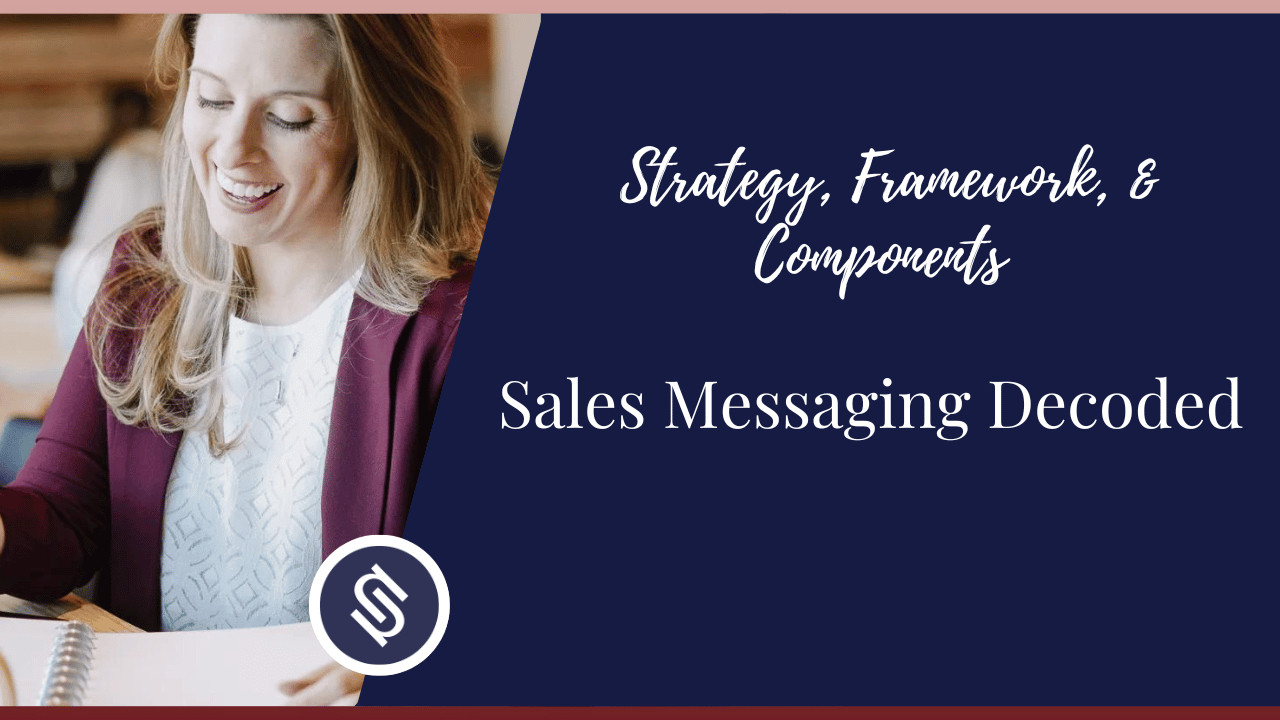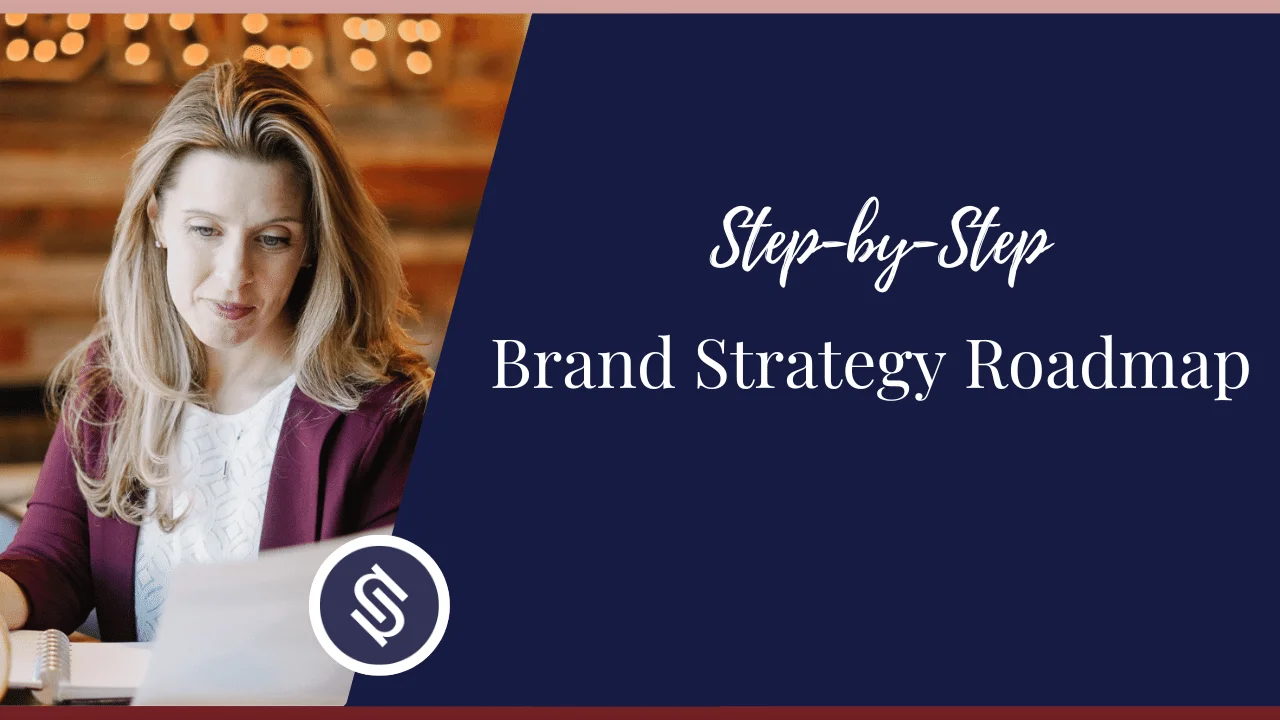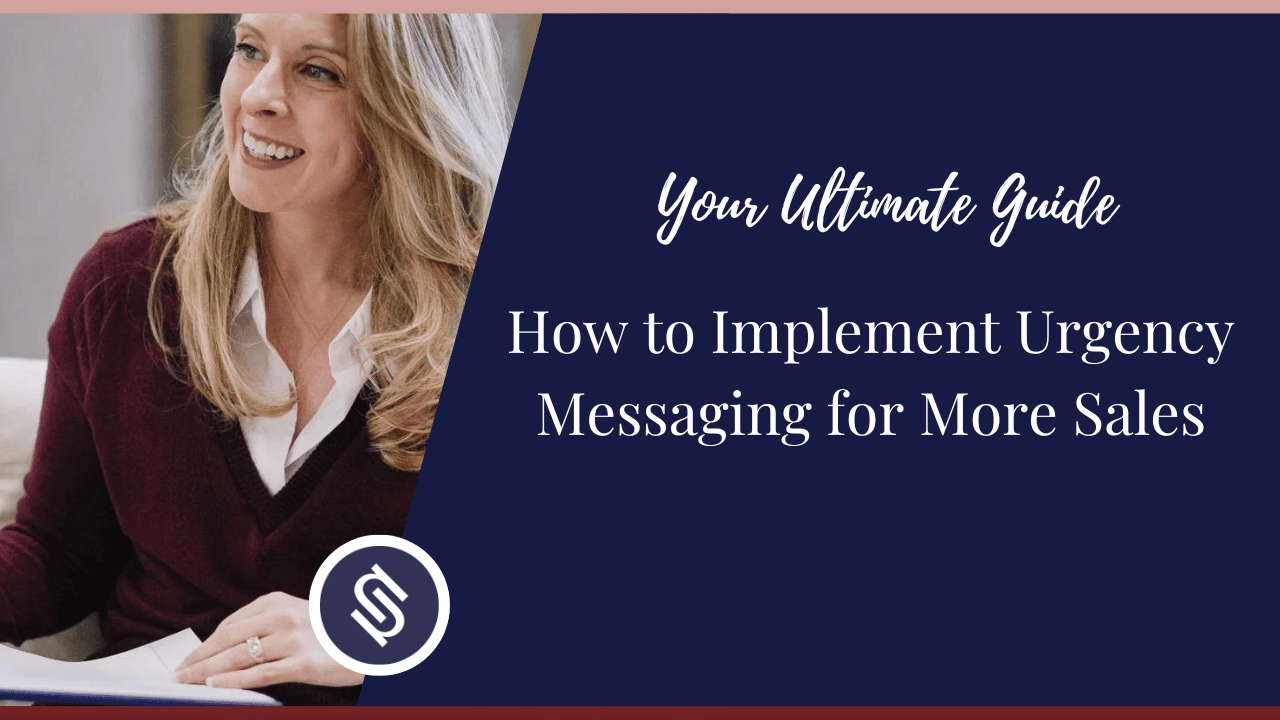A messaging strategy can take your communications from plain information scattering to a narrative that aligns with your goals and resonates with your audience.
When you’re intentional about what and how you communicate, you can speak directly to your audience’s needs and desires, creating a connection that goes beyond the transactional. You’re making them truly pay attention to you.
In this master guide, you’ll find all the messaging strategies you need and insights I’ve honed as a marketing and conversion strategist while selling over $500M worth of products and services online.
What is a Messaging Strategy?
A messaging strategy is a structured approach organizations, brands, or individuals use to communicate clearly and in line with their objectives and goals. This document outlines key components such as:
- Target audience
- Core message and key messages
- Communication channels
- Preferred tone and style
- Feedback and adaptation mechanisms
Building it takes time and multiple revisions, which is why it’s often best kept in a shared digital space.

What is the Importance of Messaging Strategy?
When communicating as a business, a strategy helps your messages resonate. Otherwise, your communication can be disjointed, ineffective, or even off-putting, leading to confusion and disconnection with your audience.
A well-crafted message strategy is the difference between just talking and being heard and understood.
Messaging Strategy Examples
Effective messaging strategies tell a story, create a vibe, and connect with the audience in unique ways. Here’s how some famous brands do it:
1. Old Spice and Humorous Messaging
Old Spice is all for funny, off-the-wall ads. Starting with those “The Man Your Man Could Smell Like” commercials, their messaging strategy focused on making you laugh while showcasing their products.
It’s like they’re saying, “Hey, we’re not just another deodorant brand, we’re here to shake things up with some fun.“
Thanks to their quirky humor, they turn a regular product into something you chat about with your friends.
2. Dove and the Promotion of Real Beauty
Dove took a unique turn with their “Real Beauty” campaign. Instead of showing off just the products, they focused on conveying that beauty is about feeling great in your skin.
Their advertising message strategy and videos often feature real stories from real people, making Dove not just a soap brand but a champion of self-esteem.
3. Apple’s Iconic iPhone Ads
This message strategy example was discussed in marketing circles countless times. The conclusion is always the same: when Apple advertises the iPhone, it’s all sleek and simple.
Messages usually focus on one cool feature at a time without bombarding you with tech jargon. Instead, they show how these features can be fun and useful in your life.
Every ad feels like a sneak peek into the future, making you excited about what your phone can do.
Enjoying this guide? Here’s how I help people like you:
- Business Coaching for Female Entrepreneurs
- Brand Messaging Consulting Services
- Business Growth Consultanting
- Message Strategy Services

12 Types of Marketing Messages
arketing messages are the core of audience communication. To create content people resonate with and respond to, you must know what messaging styles to use and when. Here are some of the most common types of marketing messages:
- Testimonials and Endorsements: Leverage positive customer or celebrity experiences to build trust and credibility.
- Corporate Social Responsibility: Highlight a company’s ethical, environmental, and social commitments to promote a responsible image.
- Educational and Informative: Offer valuable insights to deepen understanding of products, services, or relevant topics.
- Comparative Advantage: Showcase superior benefits of a product or service over competitors.
- Unique Value Proposition: Concisely explain what makes a product or service unique and preferable.
- Scarcity and Urgency: Indicate limited availability or time-limited offers to prompt immediate action.
- Lifestyle Aspiration: Link a product or service with a desirable lifestyle to appeal to audience aspirations.
- Brand Storytelling: Forge an emotional connection by narrating your brand’s origins, values, and journey.
- Emotional Appeal: Evoke feelings like happiness or nostalgia to make a product or service more relatable.
- Problem-Solution: Identify a problem and present the product or service as the solution.
- Call to Action: Directly prompt the audience to take a specific action, like purchasing or subscribing.
- Social Proof: Use others’ experiences to demonstrate a product’s popularity and effectiveness.

5 Key Components of an Effective Messaging Strategy
Cutting through the noise takes more than just words; it requires an effective messaging strategy. That’s why the following five key components can transform your communication into an impactful and memorable conversation.
1. Target Audience Understanding
Profiling your target audience should go beyond demographic data like age, gender, and location. To truly understand the people you talk to, you must delve into their psyche and grasp their motivations, challenges, and aspirations. By doing so, you’ll be able to:
- Gain behavioral insights
- Discover cultural sensitivities
- Provide effective problem-solving
- Create personalized communication
Audience research is multi-faceted and ongoing. At first, as you’re just starting out, you need to:
- Conduct market research: Gather audience data using surveys, focus groups, interviews, and tools like Google Analytics to create detailed audience personas.
- Engage directly with your audience: Use social media, forums, and community events for direct interaction, gaining nuanced insights through comments, polls, and discussions.
- Stay informed about industry trends: Subscribe to publications, attend webinars, and join professional groups to monitor industry trends.
- Use competitor analysis: Learn from your competitors’ interactions and marketing strategies to understand effective approaches in your market.
Then, as your business progresses and you have more data to look into, try to:
- Continuously update your understanding: Regularly refresh your research to spot changing audience preferences and behaviors.
- Monitor customer feedback and reviews: Keep a close eye on feedback and reviews for direct insights into audience needs, expectations, and perceptions.
- Leverage social media analytics: Use your social media data for detailed audience insights, including demographics, interests, opinions, and engagement patterns.

2. Measurable Goals and Objectives
Measurable goals and objectives give you clarity and direction in any communication effort:
- Messaging goals focus on what you want to tell your audience and how you want them to perceive your message. Examples include:
- Increase brand awareness
- Improve brand image
- Educate about a new product/service
- Business objectives are your organization’s broader strategic goals and provide the ultimate framework for your communication goals. Examples include:
- Increase sales
- Increase market share
- Improve customer loyalty
Communication goals and business objectives must align. Every act of communication should convey your message and contribute to achieving a certain business objective.
For instance, a campaign that aims to increase brand awareness (communication goal) should ultimately increase sales or market share (business objectives).
Setting and monitoring goals and objectives is a bit like navigating a ship through uncharted waters. You must be precise but adaptable and need a deep understanding of the undercurrents driving success.
You can’t just tick boxes and crunch numbers. You must use data and your intuition of market trends to make every message echo your business goals. Here are some actionable tips on how to do that:
- Define specific, measurable goals: Set SMART goals (Specific, Measurable, Achievable, Relevant, Time-bound) instead of vague aims. E.g., “Increase brand mentions on social media by 30% over the next quarter.“
- Align communication goals with business objectives: Ensure your communication goals support broader business aims for cohesive, result-driven messaging.
- Use analytics and tools: Track communication success with tools like social media analytics for brand engagement, website analytics for traffic, and sales data for direct impact.
- Review and adjust regularly: Periodically review progress (monthly, quarterly, etc.) and adjust strategies based on data insights.
- Create feedback loops: Use surveys, feedback forms, and social media interactions to gather audience insights and assess messaging effectiveness.
- Benchmark against competitors: Compare your achievements with competitors to contextualize success and identify improvement areas. Example – aiming for higher engagement rates or more effective SEO strategies.
As a marketing and conversion strategist, I can’t stress enough the importance of having a clear, detailed audience profile and communication goals before pinning down the actual messaging strategy.
Are you unsure of how to enhance your market messages and positioning? Book a 20-minute discovery call with me, and we’ll discuss what you’re looking for and how I can provide expert help.

3. Clear and Consistent Core Message
Consistent messaging comes from having a clear core message. This core message defines your business, sets the tone for every interaction you have with your audience across all platforms, and also helps you:
- Go from disjointed objectives to a unified goal
- Eliminate confusion from your offerings
- Come across as credible and reliable
- Make your brand easier to recognize
A great example of a clear and consistent core message comes from Coca-Cola. For decades, the company focused its messaging on happiness and sharing, which made it one of the most recognizable brands globally.
The same goes for Nike’s “Just Do It” slogan. Introduced in 1988, it remains, even today, a central part of their identity, reflecting a spirit of determination and achievement.
To develop your own core message, consider the following tips:
- Identify the key elements that define your brand – your mission, vision, values, and unique selling proposition – to set the foundation of your core message.
- Craft a message that is simple, direct, and easy to understand, without jargon and complex language.
- Align your core message with your visual elements – logos, color schemes, typography – to create a cohesive brand experience.
- Ensure everyone in your team understands the core message and communicates it consistently.
- Repeat your core message across all platforms and in all communications to reinforce brand identity and recognition.
- Always ensure that the core remains unchanged while adapting your message for different platforms or campaigns.

4. Compelling and Relevant Content
Crafting compelling and relevant key messages is how you take your messaging strategy to the next level.
If your core message is the foundational narrative, key messages are the versatile strands that weave into the fabric of each unique audience interaction.
As you align core and key messages and cater specifically to your audience’s interests and needs, you can achieve the following:
- Enhance audience engagement: Attract and retain attention with relevant content, increasing interaction with your brand.
- Build brand loyalty: Foster trust and loyalty by consistently delivering content that resonates with your audience.
- Facilitate personalized messaging: Tailor messages to specific audience segments, making them feel understood and valued.
- Drive desired actions: Motivate the audience to purchase or subscribe through compelling content.
- Differentiate your brand: Set your brand apart in a crowded market with unique and engaging content.
- Enhance recall and recognition: Make your brand memorable and recognizable through interesting and pertinent content.
The question is, how do you create compelling and relevant content? Consider it a dynamic process that requires a deep understanding of your brand and audience, and use the following tips to excel at it:
- Understand audience preferences: Analyze which content types and topics resonate most with your audience.
- Use storytelling with a purpose: Engage your audience with stories that reflect their values and interests.
- Follow the trends: Keep content fresh by aligning with current trends and industry news.
- Use visuals and creative formats: Enhance engagement with images, videos, and varied formats like podcasts or webinars.
- Encourage interaction: Invite audience participation through polls, quizzes, and questions for deeper engagement and insights.
- Leverage user-generated content: Feature audience-created content for authenticity and increased investment.
- Have a consistent content calendar: Plan content ahead for a regular and engaging material flow.
- Choose quality over quantity: Prioritize high-quality content to enhance shareability and memorability.
- Do SEO optimization: Use SEO strategies to boost content visibility online.
- Collect feedback and adapt: Continuously seek and incorporate feedback to improve content relevance and appeal.

5. Alignment with Brand Values and Goals
Aim to align your messaging strategy with your core values and overarching business goals. Doing so helps you with the following:
- Develop authenticity and trust.
- Ensure consistency across touchpoints.
- Set a strategic direction for communication.
- Foster employee alignment and morale.
- Establish long-term brand equity.
- Mitigate the risks of contradictory messages.
- Stay more adaptive and responsive to market changes.
If you want your business to thrive in the marketplace, you’ll need a lot more than consistent communication. You’ll need to create a brand narrative that’s cohesive, credible, and resonates both with your team and your audience.
Follow these tips to align messaging with your values and goals:
- Articulate brand values and goals: Define your core values and business goals to guide your messaging.
- Develop a messaging framework: Link your brand values and business goals to your communication strategy across various platforms.
- Train your team: Regularly train employees on brand values and goals to ensure consistent understanding and alignment.
- Develop a consistent brand voice: Use a distinct brand voice that reflects your values in all communications.
- Run content audits: Frequently audit content to ensure alignment with brand values and adjust as needed.
- Implement feedback mechanisms: Gather feedback from your audience and stakeholders to gauge messaging effectiveness.
- Monitor and adapt: Continuously assess and adapt your message strategy to stay aligned with market changes and brand goals.
- Consider crisis management: Ensure messaging during crises reflects your brand values.
- Integrate across departments: Align messaging across all departments, ensuring cohesive communication.
- Analyze and improve: Monitor competitors and industry leaders to see how you can make your messaging strategy better than theirs.

How Can a Business Develop a Strong Messaging Strategy?
The strength of a messaging strategy lies in how you integrate and execute its core components. Every strategy should implement the five key components from above, but you can turn yours into a powerhouse if you aim to:
- Use channels and formats strategically: Try a mix of channels (like social media and email) and formats (including video, text, and infographics) for your audience.
- Stay adaptable and responsive: Adjust messages and refine tactics rapidly based on market changes, audience preferences, and feedback.
- Foster innovative and creative execution: Consider unique storytelling techniques, unconventional formats, or inventive visuals in communications.
- Make data-driven decisions: Ground your strategy in reality and achieve measurable results by using data and analytics to guide decisions and track performance.
- Integrate across business functions: Create a more robust strategy by integrating messaging across all business functions — marketing, sales, customer service, and even internal communications.
The steps are straightforward, but the process requires personalization because every business is unique.
If you’re looking for personalized guidance on developing a strong messaging strategy, a coaching program with a messaging strategist might be the missing piece of your success puzzle.
Messaging Techniques Explained
Messaging techniques refer to the methods or approaches to crafting and delivering a message. They are about how you communicate a message to enhance how your audience perceives and receives it.
Below, I’ll show you the main messaging techniques, which you can use individually or in combination. The key is understanding your audience well enough to choose the most effective technique(s) for communication:
1. Storytelling
Storytelling involves weaving messages into a narrative format. Connecting information to real-life scenarios, emotions, or experiences makes it more relatable and memorable. This technique is great for building emotional connections and brand loyalty.
2. Emotional Appeal
Messages that evoke emotions can be powerful motivators for action. Tapping into feelings like happiness, fear, excitement, or nostalgia, this approach creates a bond between the audience and the message.
3. Rational Appeal
In contrast to emotional appeal, rational appeal uses logic, facts, and reasoning to persuade the audience. The technique works well with audiences that care about detailed information, statistics, and practical benefits.
4. Social Proof
Leveraging social proof involves showing that others approve of or have benefited from a product or service. Testimonials, customer reviews, and influencer endorsements are common ways to use social proof in messaging.
5. Scarcity and Urgency
This technique creates a sense of urgency or scarcity (limited availability) to encourage immediate action. You can spot it by phrases like “limited offer” or “while supplies last.”
6. Repetition
Repetition involves delivering the same idea multiple times across various channels and in different formats. With this approach, you reinforce your messages and increase brand recall.
7. Problem-Solution
This framework first highlights a problem or pain point that the audience is experiencing and then presents the product or service as the solution. When you first point out the problem, you demonstrate the value and relevance of what’s being offered.
8. Comparative Messaging
Comparison involves putting a product or service next to the main competitor(s) to highlight its advantages. Comparative messaging is useful for audiences already aware of and considering similar options.
9. Visual Messaging
Using images, videos, infographics, and other visual elements helps convey a message better.
DID YOU KNOW?
People can identify an image in 13 milliseconds, and visuals impact emotions faster and stronger than words. According to the dual-coding theory, our brains process visuals and words through different channels, making us more likely to remember messages backed up by graphics.

What Role Does Audience Analysis Play in Messaging Strategy?
Audience analysis deciphers who your audience is and why they think, feel, and act the way they do. The insights you gain from it can take your messaging from good to extraordinary. Just consider these direct benefits of deep audience understanding:
- Create more relevant and personal messages that increase engagement.
- Use empathy to present your offer as a relatable solution for your audience.
- Craft culturally sensitive and relatable messages that foster respect.
- Use your audience’s habits and behaviors to place messages where they are most likely to be seen and acted upon.
- Continually refine your messaging to keep it relevant and impactful over time.
- Segment your audience into groups and create messages that appeal to each one.
- Anticipate future behaviors and preferences based on current trends and data.
- Uncover and address needs and desires that others may have overlooked, gaining a competitive edge.
Enjoying this guide? Bookmark these for later:

What is a Messaging Strategy Framework?
A messaging strategy framework is a structured approach to creating and implementing your messaging across different channels and audience segments.
This framework provides a comprehensive guide for crafting and disseminating messages, ensuring they are consistent, targeted, and aligned with your marketing and business objectives.
Here’s how this framework might look for a solopreneur in the field of personal fitness specializing in online fitness coaching.
Assume they’re launching a flagship program called “Fit4Life: 12-Week Total Transformation,” the coach will need to go through:
| Task | Findings / Actions |
|---|---|
| 1. Audience analysis | Research to understand the target audience: Busy professionals in their 30s and 40s looking to improve their fitness and health. They value efficient workouts, clear guidance, and evidence-based nutritional advice. |
| 2. Core message development | Based on their brand values of empowerment, health, and sustainability, the coach might go for the following core message: “Transform your life with sustainable fitness and nutrition habits.” This message encapsulates the essence of "Fit4Life" and aligns with the brand’s ethos. |
| 3. Audience segmentation and message tailoring | Audience segments include beginners needing more guidance and experienced individuals seeking advanced techniques. They tailor messages for each segment, like “Start your fitness journey with confidence” for beginners and “Elevate your fitness game” for the experienced group. |
| 4. Channel strategy | LinkedIn and Instagram are popular platforms among their target audience. They decide to use them for outreach, focusing on: Instagram for motivational posts and workout snippets. LinkedIn for sharing health tips and success stories. |
| 5. Content calendar | They develop a content calendar that schedules daily posts on Instagram, weekly articles on LinkedIn, and bi-weekly email newsletters. This calendar ensures consistent engagement with the audience and keeps the program top-of-mind. |
| 6. Feedback and measurement | They use social media analytics to track engagement and email open rates to gauge the effectiveness of their messaging. They also actively seek feedback through comments and direct messages to understand audience responses and adjust the strategy accordingly. |
| 7. Integration with overall marketing strategy | The message strategy for "Fit4Life" is integrated into the broader marketing plan, which includes: Promotional offers Collaboration with health influencers Participation in virtual fitness events This integration ensures a cohesive and comprehensive marketing approach. |
What is a Value Messaging Framework?
A value messaging framework is a strategic tool used in marketing and communications to clearly define and articulate the unique value proposition (UVP) of a product, service, or brand to its target audience.
Value messaging aims to go from listing features or technical specifications to showing the value and benefits the audience will gain. The goal is to make a stronger connection with potential customers and differentiate the brand in a crowded marketplace.
If we apply the Value Messaging Framework to our fitness coach example and their “Fit4Life: 12-Week Total Transformation” program, here’s what we might get:
| Task | Findings / Actions |
|---|---|
| 1. Target audience identification | Busy professionals in their 30s and 40s who: Struggle to find time for fitness. Seek structured guidance. Desire a sustainable approach to health. |
| 2. Unique Value Proposition | "Transform Your Life in Just 12 Weeks: Achieve lasting fitness and health with personalized coaching, tailored nutrition plans, and a supportive community." |
| 3. Benefits articulation | Personalized fitness plans. Comprehensive nutritional guidance. Ongoing support and motivation. |
| 4. Proof points | Success stories, testimonials, and before-and-after photos from previous clients. Highlighting the coach’s certifications and experience in fitness and nutrition. |
| 5. Differentiators | Offering flexible online coaching adaptable to any schedule. A holistic approach focusing on both fitness and nutrition. Personalized attention with one-on-one coaching sessions. |
| 6. Emotional connection | Messaging focuses on: The empowerment of achieving health goals. The joy of leading a healthier lifestyle. The confidence that comes with improved fitness. |
| 7. Call to Action | "Join the Fit4Life program today and start your journey towards a healthier, happier you! Sign up now for a free initial consultation." |
| 8. Consistency across channels | Ensure consistent value messaging across the program’s website, social media, emails, and promotional materials. |
5 Mistakes to Avoid in Developing a Messaging Strategy
While a well-executed strategy can take your business to new heights, certain common mistakes will undermine even the most promising efforts. Beware of the following pitfalls.
1. Lack of Audience Insight
If you don’t understand your target audience, your messages can easily be too generic or misaligned. Imagine a business targeting millennials that uses a formal tone or outdated references. They’ll likely see poor engagement.
2. Inconsistent Messaging
Inconsistent messaging across various platforms can confuse your audience about your identity and values. For instance, if your brand is casual and friendly on social media but formal and corporate on your website, it creates a disjointed brand experience.
3. Overcomplicating the Message
Complex jargon or overly technical language can be off-putting. Even a tech company using too much technical language in its consumer marketing may fail to connect with its audience.
4. Ignoring Feedback and Data
Neglecting audience feedback and data analytics can hinder the effectiveness of your messaging. Say your data shows that the audience engages more with video content, but you continue to focus on text-heavy posts. You’re likely missing out on engagement opportunities.
5. Neglecting Call-to-Action
Without a clear CTA, even the most engaging content can fail to achieve its desired action. For example, a promotional email that informs but doesn’t direct the reader to take an action (like “Buy Now” or “Learn More”) results in lost sale opportunities.

Frequently Asked Questions (FAQs)
To wrap up the talk around messaging strategy best practices, here’s a short FAQ with two important questions to consider.
How Can I Incorporate Storytelling in Messaging?
Start by identifying relatable scenarios or challenges your audience faces. Then, craft a story where your product or service plays a key role in resolving these challenges or enhancing the user’s experience.
Ensure the story aligns with your brand values and is told in a tone that resonates with your audience. The goal is to create a memorable and engaging experience that strengthens the relationship between your brand and your customers.
What’s the Best Approach to Multilingual Messaging Strategies?
Multilingual messaging requires tailoring the language and the medium for each target audience. Instead of plain, direct translation, localize the content to reflect cultural nuances, idioms, and regional preferences.
Collaborate with native speakers or localization experts to adapt your messaging appropriately. Additionally, understand the specific media consumption habits and channels popular in each region.
Conclusion
Congratulations on making it to the end of this extensive messaging strategy guide! I can tell you’re highly motivated to thrive in your business, and just by gaining this knowledge, you’re halfway there.
If you’re eager to put these insights into practice but could use expert assistance, I’d be happy to help. I’m Nora Sudduth, a leading marketing and conversion strategist obsessed with client success and with a track record of selling over $500M of products and services online.
Book a discovery call, and we’ll figure out what you need and how I can help set your business up for success with strategic messaging that makes sense.







